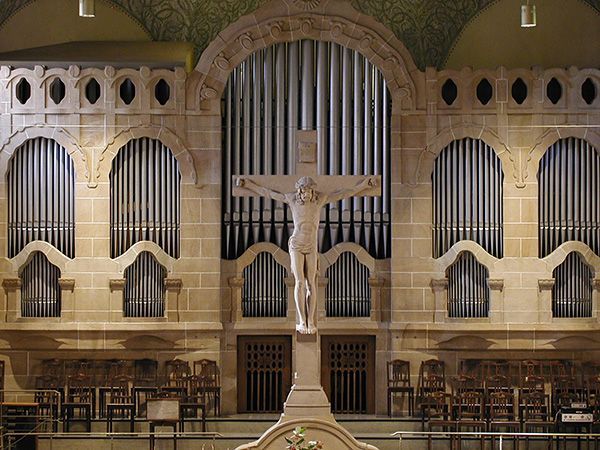Ausführliche Beschreibung der vorgewählten Orgel

Quelle: Markusgemeinde Stuttgart
Stuttgart, Deutschland (Baden-Württemberg) - Evangelische Markus-Kirche (Haigst)
Gemeinde: Stuttgart
Region:Württemberg
Adresse: Filderstraße 22, 70180, Stuttgart
Website: https://www.markus-haigst.de/
Beschreibung nr.: 2001510.
Gebaut von: E.F. Walcker & Cie. (1908) - Opus 1400
The organ in the Markuskirche in Stuttgart was built in 1908 by the company Walcker. Consultant was Heinrich Dolmetsch. The same company rebuilt the instrument in 1955 according to contemporary ideas about organ design and specifications. Consultants were Walther Lutz and Karl Gerock. In 1978 the organ was overhauled by Walcker. During these works, the Oktavkornett 2 fach of the Hauptwerk has been replaced with an Oktave 2'. On the Positiv the Lieblich Gedackt 8' was adapted into a Flöte 8' and the Trompetenregal 4' was replaced with a Hautbois 4'. The pedal specification has also been altered. The Flötenbaß 8' + 4' was split into a Gemshorn 8' and a Waldflöte 4'. The Terzbaß 6 2/5' was replaced with a Bombarde 32'.
Technische Daten
Disposition
Hauptwerk (C-g'''): Prinzipal 16', Quintade 16', Prinzipal 8', Großgedackt 8', Spitzpfeife 8', Quintflöte 5 1/3', Oktave 4', Rohrflöte 4', Nasat 2 2/3', Oktave 2', Feldflöte 2', Kornett 2 fach (2 2/3'), Mixtur 5-6 fach (2'), Kleinmixtur 3 fach (2/3'), Fagott 16', Trompete 8', Tremulant - voor de Sololade.
Positiv (C-g'''): Harfenprinzipal 8', Flöte 8', Quintade 8', Prinzipal 4', Blockflöte 4', Oktave 2', Koppelflöte 2', Terz 1 3/5', Quinte 1 1/3', Oktävlein 1', Scharff 5 fach (1'), Krummhorn 8', Hautbois 4', Tremulant.
Schwellwerk (C-g'''): Bordun 16', Prinzipal 8', Rohrgedeckt 8', Salizional 8', Oktave 4', Nachthorn 4', Geigenschwebung 4', Spitzflöte 2', Sifflöte 1', Sesquialter 2 fach (2 2/3'), Schreipfeife 3 fach, Mixtur 6 fach (1 1/3'), Quintzimbel 3 fach (1/4'), Dulzian 16', Oboe 8', Vox Humana 8', Schalmey 4', Tremulant.
Pedal (C-f'): Prinzipalbaß 16', Subbaß 16', Gedecktbaß 16' - transmissie, Quintbaß 10 2/3', Oktavbaß 8', Gemshorn 8', Waldflöte 4', Holzflöte 2', Choralbaß 3 fach (4'), Hintersatz 6 fach (5 1/3'), Bombarde 32', Posaune 16', Dulzian 16' - transmissie, Trompete 8', Klarine 4', Singend Kornett 2', Tremulant - voor de Sololade.
Sonstige Register: Zimbelstern.
Koppeln: Hauptwerk - Positiv, Hauptwerk - Schwellwerk, Positiv - Schwellwerk, Schwellwerk - Positiv, Pedal - Hauptwerk, Pedal - Positiv, Pedal - Schwellwerk, Solo Positiv - Hauptwerk, Solo Positiv - Schwellwerk, Positiv Ab, Pedal - Schwellwerk 4'.
Nebenregister und Spielhilfen: 4 freie Kombinationen, 2 freie Pedalkombinationen, Organo Pleno, Tutti, Automatische Pedalumschaltung III. Manual, Registercrescendo (Walze), Zungen ab.

Quelle: Markusgemeinde Stuttgart
Stuttgart, Deutschland (Baden-Württemberg) - Evangelische Markus-Kirche (Haigst)
Gemeinde: Stuttgart
Region:Württemberg
Adresse: Filderstraße 22, 70180, Stuttgart
Website: https://www.markus-haigst.de/
Beschreibung nr.: 2001510.
Gebaut von: E.F. Walcker & Cie. (1908) - Opus 1400
| Jahr | Orgelbauer | Opus | Aktivität | 1908 | E.F. Walcker & Cie. | 1400 | Neubau | 1955 | E.F. Walcker & Cie. | Umbau | 1978 | E.F. Walcker & Cie. | Restaurierung |
The organ in the Markuskirche in Stuttgart was built in 1908 by the company Walcker. Consultant was Heinrich Dolmetsch. The same company rebuilt the instrument in 1955 according to contemporary ideas about organ design and specifications. Consultants were Walther Lutz and Karl Gerock. In 1978 the organ was overhauled by Walcker. During these works, the Oktavkornett 2 fach of the Hauptwerk has been replaced with an Oktave 2'. On the Positiv the Lieblich Gedackt 8' was adapted into a Flöte 8' and the Trompetenregal 4' was replaced with a Hautbois 4'. The pedal specification has also been altered. The Flötenbaß 8' + 4' was split into a Gemshorn 8' and a Waldflöte 4'. The Terzbaß 6 2/5' was replaced with a Bombarde 32'.
Technische Daten
| Anzahl Register pro Manual | |
| - Hauptwerk | 16 |
| - Positiv | 13 |
| - Schwellwerk | 17 |
| - Pedal | 16 (14) |
| Gesamtzahl der Stimmen | 62 (60) |
| Tastentraktur | Electropneumatic |
| Registertraktur | Electropneumatic |
| Windlade(n) | Slider chests |
Disposition
Hauptwerk (C-g'''): Prinzipal 16', Quintade 16', Prinzipal 8', Großgedackt 8', Spitzpfeife 8', Quintflöte 5 1/3', Oktave 4', Rohrflöte 4', Nasat 2 2/3', Oktave 2', Feldflöte 2', Kornett 2 fach (2 2/3'), Mixtur 5-6 fach (2'), Kleinmixtur 3 fach (2/3'), Fagott 16', Trompete 8', Tremulant - voor de Sololade.
Positiv (C-g'''): Harfenprinzipal 8', Flöte 8', Quintade 8', Prinzipal 4', Blockflöte 4', Oktave 2', Koppelflöte 2', Terz 1 3/5', Quinte 1 1/3', Oktävlein 1', Scharff 5 fach (1'), Krummhorn 8', Hautbois 4', Tremulant.
Schwellwerk (C-g'''): Bordun 16', Prinzipal 8', Rohrgedeckt 8', Salizional 8', Oktave 4', Nachthorn 4', Geigenschwebung 4', Spitzflöte 2', Sifflöte 1', Sesquialter 2 fach (2 2/3'), Schreipfeife 3 fach, Mixtur 6 fach (1 1/3'), Quintzimbel 3 fach (1/4'), Dulzian 16', Oboe 8', Vox Humana 8', Schalmey 4', Tremulant.
Pedal (C-f'): Prinzipalbaß 16', Subbaß 16', Gedecktbaß 16' - transmissie, Quintbaß 10 2/3', Oktavbaß 8', Gemshorn 8', Waldflöte 4', Holzflöte 2', Choralbaß 3 fach (4'), Hintersatz 6 fach (5 1/3'), Bombarde 32', Posaune 16', Dulzian 16' - transmissie, Trompete 8', Klarine 4', Singend Kornett 2', Tremulant - voor de Sololade.
Sonstige Register: Zimbelstern.
Koppeln: Hauptwerk - Positiv, Hauptwerk - Schwellwerk, Positiv - Schwellwerk, Schwellwerk - Positiv, Pedal - Hauptwerk, Pedal - Positiv, Pedal - Schwellwerk, Solo Positiv - Hauptwerk, Solo Positiv - Schwellwerk, Positiv Ab, Pedal - Schwellwerk 4'.
Nebenregister und Spielhilfen: 4 freie Kombinationen, 2 freie Pedalkombinationen, Organo Pleno, Tutti, Automatische Pedalumschaltung III. Manual, Registercrescendo (Walze), Zungen ab.
| Literatur |
|
| Weblinks |
https://www.markus-haigst.de/bildung-kultur/die-markuskirche/die-orgel.html http://www.kirchen-online.org/kirchen--kapellen-in-stuttgart/stuttgart---markuskirche.php |
